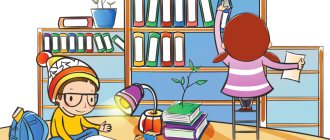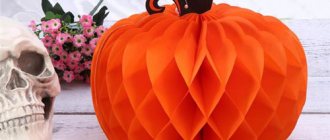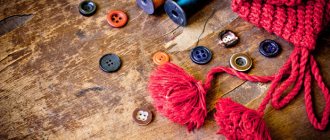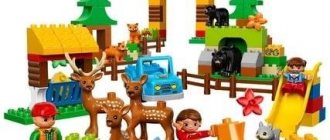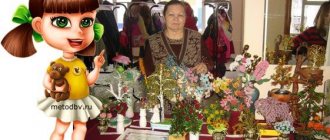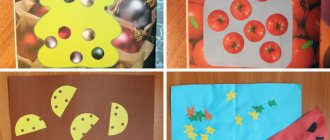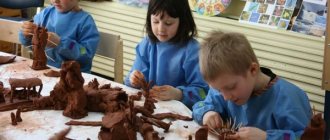I_A_Lykova_konstruirovanie_mladshaya_gr
the variety of its types ( writing, toilet, packaging, napkins, etc.),
cardboard, corrugated cardboard, fabric, foil, soft wire for children's creativity, natural materials
(sand, snow, pebbles, shells, cones, acorns, nuts, etc.).
The teacher shows the children how to transform
household and natural materials in various designs:
folding, laying out based on a silhouette or contour drawing, molding, creasing and revealing the image in the resulting form, combining several forms into one meaningful whole.
In all educational situations, the teacher draws children's attention to the fact that the result (design) differs from the source material and constituent elements. Children, in collaboration with the teacher and other children or individually, create buildings from sand, snow, paper
(torn strips and crumpled lumps), fabric, safe natural and household materials. The themes of these designs are attractive to children: a house, a fence, a city, a cake, a flower, a sheep, a cloud, the sun, a man and many other images.
Options for basic buildings in children's design
Road
An idea of the road.
A road is a structure specially created by people for ease of movement in space; a place where you can walk or drive; path or route to follow.
Children construct roads and paths from various materials - construction materials (bricks, bars, plates) and household materials: dish sponges, plasticine bars, pencils (one for a narrow path and two or three for a wide path), paper strips, laces, ribbons , braids, jump ropes, pyramid rings, socks, pebbles, nuts, peach pits, sweets, biscuits (cookies), magnets on a magnetic board, rugs, silhouettes of footprints cut out of paper (cardboard, fabric, felt), etc.
Track options: narrow and wide, long and short, straight and curved, comfortable and inconvenient.
Bridge
What is a bridge?
A structure that people build across some large barrier - a river, lake, swamp, ravine, strait, railway, car*.'
= - gistral, etc. There are bridges. : wood, stone, metal, even from ropes and rods (veto*. People can walk along the bridge or go by transport Children construct a bridge: bricks, bars, plastic, foam sponges, twigs* sticks ,
unsharpened pencil and other materials.
P
Bridge options: long and short, wide and narrow, high and low, with steps, railings and slopes.
Fence (fencing)
What is a fence?
A structure to protect someone (people, pets) or something (home, property, land, garden) from possible attack, destruction and destruction by people and animals or natural phenomena (wind, hurricane, flood).
Children construct a fence and a wall from various materials - construction materials (bricks, cubes, bars) and household materials - dish sponges, plasticine bars, plastic cups, cardboard boxes, plastic bottles and packaging, pieces of furniture (toys, children's), skittles, etc. .
Options for fences: high and low, long and short, open (linear) and closed (closed).
Tower
What is a tower?
A tall, pillar-like structure that may stand alone or be part of a building. A tower can also be called a pile of objects in the form of a tall structure. The tower can be round, tetrahedral or polygonal in shape - just like a pyramid. But, unlike a pyramid, the tower does not taper at the top. Symbolism
towers - ascension and vigilance.
Children construct towers from elements of the same size - construction (cubes, bricks) and household items: hats, pillows, plastic cups, molds for playing with sand, saucepans, etc.
Turret options: high and low, wide and narrow, stable and unstable, straight and curved.
House (dwelling)
What is a house (dwelling)
^A structure created by man for a comfortable life. In the house a person is protected from heat and cold, from rain and snow, from wind and frost, from wild animals and unkind people. The house resembles a box closed on all sides. There is a floor at the bottom, a roof at the top, and walls on the sides. There are windows and a door on the walls. Windows are needed to keep the house light and to look out into the street, which is why they say: “windows are the eyes of the house.” A door is needed so that you can enter and leave the house. People make their houses from wood, stone, bricks and other materials.
Children construct houses from building materials
(table and floor constructors), pieces of furniture (chairs) and fabric, cardboard packages of various shapes.
| t2 CONSTRUCTION IN KINDERGARTEN (3-4 YEARS) |
Options for houses: large and small, high and low, rural and urban, one-story and two-, three-story.
Furniture
What is furniture?
These are objects created by man for convenience in everyday life: to make eating, sleeping, sitting, and storing things more convenient, pleasant, and even beautiful. Sit comfortably on a chair, armchair, bench or sofa. Sitting at a table makes it more convenient for a person to eat, write, read and work. It is more convenient to store things in a closet or chest. The most comfortable place to sleep is on a bed or sofa. Each piece of furniture has its own special design. The table has a tabletop and stable legs. The wardrobe looks like a large box with a door, and inside it has shelves and hangers for storing things.
Children construct furniture from bricks, cubes, plates, bars and other materials - cardboard boxes, sofa cushions, foam sponges.
Options for pieces of furniture depend on their design: the bed can be wide or narrow, long or short, with or without legs; the sofa and armchair can be folding, and the bedside table can turn into a closet.
Transfer of mastered methods to new situations (educational, gaming, everyday). Throughout the school year and during the summer, the teacher creates situations for transfer
mastered methods into new semantic contexts. As a result, children freely and confidently create various buildings (paths, fences, ladders, houses, sofas, bridges, etc.) from all kinds of materials: bricks, cubes, plates, sponges for washing dishes, cardboard boxes, plasticine bars, pencils, paper strips , laces, ribbons, braids, magnets (on a magnetic board, refrigerator) and other items. At the same time, they easily establish a connection between their buildings and real architectural structures or everyday objects.
Pedagogical diagnostics
For current diagnostics, the teacher analyzes not only the result obtained, but also the construction process and the children’s attitude towards this activity. In this case, it is guided by the fact that by the age of four the child already:
- meaningfully (purposefully) creates and freely plays with simple buildings (path, fence, flowerbed, bridge, ladder, sofa, armchair, table, chair, tower, house, garage, slide, train, boat, etc.), understands the connection between buildings and real structures or household items;
- knows basic design methods: places parts in space in such a way that when they are combined
/5
When united, the intended design was obtained - horizontal or vertical, linear or closed (puts, puts, puts on top of each other, attaches, etc.);
- distinguishes, correctly names and independently uses the main building parts for their intended purpose: cube, brick, plate (square and rectangular), prism (trihedral), half-cube (tetrahedral prism), block (long and short);
- understands the dependence of the shape, size, beauty and stability of the structure on the characteristics of the parts (shape, color, quantity, placement in space); can make adequate replacement parts;
- independently experiments with various materials: construction, natural (sand, snow, cones, acorns, pebbles, shells) and household (paper, fabric, foil), studies their properties and creates designs according to a plan, theme or creative task (bird, cloud) , flower, candy, house, etc.).
Planning
INK "September SHSHYASSH
1. Here are the different paths we have (made from different materials).
2. How the narrow path became wide (made of bricks).
3. How the path turned into a labyrinth (made of foam sponges or bricks).
4. How a straight path turned into a curve (from laces, ribbons, jump ropes).
October
5. How mushrooms grew in the forest near the path (from different materials).
6. How the berries ripened on the bushes (from paper napkins).
7. How cones turned into birds and fish (from natural material).
8. How the clouds became clouds and it began to rain (from paper napkins).
November
9. How a short fence became long (made of bricks).
10. How the gate (made of bricks) opened on the fence.
11. How the fence turned into a fence (made of bricks).
12. How a low tower became high (from cubes and other shapes). December
13. How an ordinary tower became unusual (from cubes and half-cubes).
14. How the tower turned into a pyramid (experimentation).
15. These are the different Christmas trees we have (from different materials).
16. How nuts turned into apples (from walnuts and foil).
January
17. How a snowman turned into a tumbler (from snow on a walk).
| 14 CONSTRUCTION IN KINDERGARTEN (3-4 YEARS) |
18. How the ladder turned into a slide (from cubes and a plate).
19. How an uncomfortable crib became comfortable (made of bricks, half-cubes, bars).
20. How a chair became a folding sofa (made of bricks and half-cubes).
February
21. How the ladder turned into a railroad (on a plane made of bars).
22. These are the different types of cars we have (made from building materials).
23. How we built a garage for a car (from bricks).
24. How a carrot turned into an icicle (from foil).
March
25. Here are the different bouquets of flowers we have (from paper napkins).
26. How we built a table on four legs (from bars and plates).
27. How a chair turned into a bedside table (from bricks and half-cubes)
28. How the bedside table turned into a closet (made of bricks and half-cubes).
April
29. How snowdrifts turned into streams and puddles (from household materials).
30. How a dangerous bridge became safe (from building materials).
31. How the boat turned into a boat (from building materials).
32. How a boat turned into a rocket (from different materials).
■NN May SHSL
33. These are the beautiful flower beds we have (made from building materials).
34. How we set off festive fireworks (from household materials).
35. These are the beautiful houses we have in our village (made of building materials).
36. How our city grew and grew and grew! (from building material).
Note.
During the academic year,
18
classes are conducted in designing from building materials, 14 from household materials (paper, fabric, foil) and
4
from natural materials.
This division into types is arbitrary, since many topics require free choice of materials by the teacher and children. The priority is the task of what and how to do,
and not
from what.
In addition, in independent activities, children freely transfer the mastered methods and types of structures to various materials and buildings.
Photo 10. Variants of Christmas trees made from different materials were created by children of the second junior group D00 “Miracle Kindergarten”, Moscow.
/5
| September Construction from various materials |
Educational objectives.
Help children establish associative connections between real paths and structures made of various materials - bricks, cubes, plates, foam sponges, plasticine bars, etc. Clarify and generalize the idea of a road as a structure created for ease of movement in space. Expand track design experience. Create conditions for free choice of materials. Develop associative perception, visual thinking, imagination. Cultivate interest in designing and playing around with buildings.
Basic concepts, skills and abilities.
The idea that the whole (track) is created through the process of combining parts
(bricks).
Materials, tools, equipment.
Various materials for children to choose from: bricks, cubes, plates, foam sponges, plastic lids, plasticine bars, unsharpened pencils, paper strips, pebbles, etc. Toys for playing with buildings - dolls, cars, zoological toys, balls and substitute objects. Illustrations and photographs depicting paths for
clarifications
representations and establishing associations with buildings (demonstrated before and after construction).
GCD content
Children sit freely and comfortably on the floor. The teacher shows images of various paths - photographs, illustrations, reproductions (if possible uses information and communication technologies) and drawings by children of senior preschool age. He asks what a road is, what is it for, where have the children seen real paths? It helps to comprehend and generalize the idea that a road is a structure specially created by people to make it convenient for them to walk and drive.
The teacher suggests remembering the method of constructing a track. If the children have not previously attended kindergarten, he shows how to create a linear structure - he lays three or four bricks in a row one by one and explains: “I lay one brick, then a second, and then a third - like this!”
| GB CONSTRUCTION IN KINDERGARTEN (3-4 YEARS) |
I press the bricks tightly - the path is ro-o-ov! The doll will walk and not fall.” Plays with the building using a toy. The gesture emphasizes the linear nature of the building: “What a long path!” If in a group
There are children who have previously attended kindergarten and know this basic method, asks one active child to show other children how to build a path from bricks.
Then the teacher invites the children to choose construction materials of their choice and build smooth paths on the floor. Helps you make a choice and provides individual support during the work process. When the buildings are ready, he invites you to play and see if the dolls and animals can get through and the cars can pass. The educational situation can smoothly transition into free play.
Content customization
is ensured by a free choice of material both in terms of its quality (shape, color, size, texture) and quantity (from three to ten to twelve parts in one track).
Understanding the result.
Immediately after finishing work or after some time (but on the same day), the teacher asks the children what a road is, why there are different paths, how we got such different paths (
built from different materials, long and short, narrow and wide ).
For a deeper understanding, he reads to the children V. Shipunova’s poem “That’s how different they are”: There are many paths in the world for wheels, hooves and legs:
Long, short,
Narrow, wide,
Clean and dirty.
That's how different they are!
Independent activity.
Children at home and in kindergarten
Xie
Construct paths from different
materials
.
br
_
Integration of activities.
Children “find” roads and paths on the street.
They look at pictures of different roads and listen to poems [see.
Annex 1). They walk along tactile paths in the music room or in the corridor
[see.
Appendix 2). Draw paths with pencils, felt-tip pens, and crayons.
Clarify the idea of the road, its purpose and the most characteristic features. They try to create common path constructions, working in pairs or small groups. Compare buildings in terms of length, width, number of parts. The teacher promotes the understanding and accurate use of the words long/short, narrow/wide, straight/crooked, clean/dirty, comfortable/inconvenient;
build, brick, plate, cube. Interaction with family.
At the information stand, the teacher places a card with options for buildings and advises parents to take a walk with their children in search of paths and observe their creation or cleaning. If desired, parents can bring photographs to kindergarten to decorate an album or newspaper “What paths do we walk along with mom and dad?”
/7
Advice for parents and educators
A very important point that should not be missed is scissors. They should be rounded. During work, adults should never leave their children a single step. After all, they have dangerous objects. During the construction period, children learn not only about technology. Pay attention to colors, geometric shapes, paper density, etc. You can even make crafts from newsprint. Children love such a subject as design. The 2nd younger group is just learning it, so show as much warmth and patience as possible.
Even if your child fails at something, but you see that he is trying, be sure to praise him. For children 2-3 years old it is very important to hear that they are able to cope with the task. There is no need to do difficult tasks right away. To begin, let the baby crumple the paper or tear it. This is the first thing a child should know and love. When you are fully familiar with the material, then just proceed to the main task. Construction in the second youngest group is more difficult than for older children, since they do not yet have the necessary skills and experience. Only thanks to adults does the baby develop precision of movement and orientation in space. Before making origami-type crafts, teach your child to simply fold paper or cardboard in half. Only when the child learns to understand where the center is, he will begin to succeed in crafts. Develop your children every day, let them please you with their successes.
Construction at preschool educational institutions: junior group
For children 2-3 years old, the teacher suggests making crafts from blanks. As a rule, design in the second junior group begins at the beginning of the semester with simple stripes. The teacher gives them several pieces of the same length and width. Let's try to make a "bunny". Take one strip and glue its ends together. The result is a head. Glue the ears in separate strips. Separately, we make a bridge to which the head is attached. Look at the photos to see what the bunny looks like.
Near it, help your child make grass, flowers, a bridge, etc. Let your child help you fantasize. The eyes can be made from a button or simply cut out circles from colored paper. We make the nose and mouth in the same way. Kids will love building. The 2nd junior group is the age when kids are very inquisitive and can easily imagine. Help them develop in this direction.
